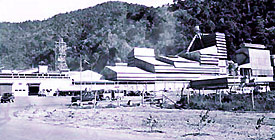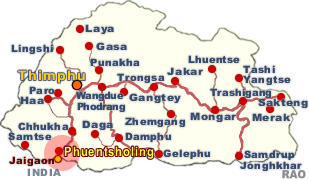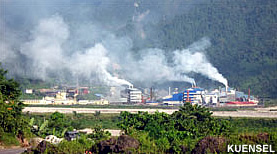 |
Bhutan's
Economy |
|
 |
Bhutan Information |
|
|
 |
|
The
industrial town of Pasakha
|
 |
 |
| One of the factories in Pasakha |
| Amidst
rows of large factory sheds, numerous workers in overalls work round the
clock in shifts. Ten-wheelers and other trucks move in and out of the factories
day and night. The greenery around has a thin coating of dust. With industrial
investment of more than Nu 2.6 billion since 1986, Pasakha, about 17 kilometres
from Phuentsholing, is poised to become Bhutan's first major industrial
town. |
|
It
is already home to several large industries - Bhutan carbide and chemicals
(BCCL), Bhutan ferro alloys limited (BFAL), Tashi carbon, all of which
were established in the early 1990s. Other factories include the expanded
and upgraded Druk cement plant and a furniture unit of the Bhutan board
products limited (BBPL). More recently, Bhutan beverages company limited
(BBCL) a soft drink bottling plant under the Tashi Group began commercial
production this year. There are also several other small and medium size
industries that have been established in Pasakha in the last few years.
 |
Pasakha's
growth as a major industrial town would have been faster had it not been
for the devastating floods of August 2000. The Basra river damaged residential
areas, telecommunication and power lines, and even some of the factories.
Pasakha is back on track although the scars of the floods
are still visible.
The
industries situated along the Barsa river, like the BCCL and BFAL, have
taken costly measures against future floods. |
|
River
training works and construction of retention walls and spurs have cost
the two companies about Nu 100 million. The riverbed is dredged every year
to keep the level of the water lower than the walls.
In
fact 2000 was not the first time Pasakha experienced floods. There was
an earlier flood in 1996 that washed away tonnes of raw materials and damaged
factory premises.Despite the natural hazards of landslides and floods,
Pasakha is still the place for setting up an industry in Bhutan says Mr
K Koti Reddy, chief executive (works), BCCL.
|
Much
of it has got to do with its location. Pasakha was ideal for mineral based
industries because mineral sources were close by. Quartz, dolomite and
limestone are available in Pachina, Kamji, Tintali and Gomtu, less than
100 kilometers away. Its proximity to the Indian border enabled easy movement
and marketing of products, import of raw materials, labour and transport. |
 |
Pasakha,
according to Reddy, also had an ample and reliable supply of power which
was important for any industry. Another advantage was the double lane road
between Phuentsholing and Pasakha making it convenient for large trucks
to ferry finished products and raw materials. On an average, about 60 trucks
ply on this route every day. Traffic is expected to increase further with
the opening of the Pasakha-Manitar national highway.
 |
|
Many
new industries want to cash in on these advantages. There is already a
proposal to set up four major industries and several small industries at
the Singaybasti industrial site, identified by the ministry of trade and
industry and approved by the government.
Located on the confluence of Barsa river and Singye chu, the new site is about one kilometre from BFAL factory.
|
|
The site has about 70 acres of usable land that will be leased to interested Bhutanese companies and entrepreneurs.
Site development and river protection work along its boundaries are already in process. A two-kilometre long, five-meter high retention wall will also be built as a flood protection measure.
The
site will house only production and manufacturing (PAM) industries that
consume considerable amounts of electricity," said an assistant trade officer
in Phuentsholing. Meanwhile, about 29 thram holders of Singyebasti have
been provided with alternative land of their choice in Balujohra geog in
Phuentsholing.
The
Tashi group of companies has already applied for about 60 acres of land
to construct carbon silicon manganese, calcium silicide and magnesium metal
factories as well as a brewery at the new site. "We are ready to go ahead
with the construction of beer and low carbon silicon manganese factories,"
said Mr. Reddy. "We are just waiting for the land allocation." He added
that the other two calcium silicide and magnesium metal factories would
be built within the next two years. According to Reddy, the construction
of four new large-scale industries would catapult the growth of Pasakha
and create job opportunities for about 1,000 workers. Hundreds of other
jobs would also be available in small-scale industries like the proposed
jute and welding electrodes manufacturing units in the area.
With
an expected increase in the working population, Pasakha will also need
more schools and other services for children of the factory employees.
It also needs a hospital. "We had a post office and a small health unit
but they were washed away by the flood and, since then, we do not have
any," said a resident of Balujhora. It also needs more residential area.
Half of the 38 three-storey residential buildings of the BCCL and BFAL
were washed away by the 2000 floods.
According
to survey officials, the search for feasible land for the construction
of housing colonies, a bank, and a well-equipped hospital was being carried
out. A possible place identified by the surveyors is the Gurungdara and
Chengmari area, about 1.5 kilometers from the industrial site. There is
infrastructure to be built but factory officials feel that Pasakha has
enormous potential to develop subsidiary industries and to expand the existing
ones. It will be a town to be reckoned with.
| Contributed
by Passang Norbu, KUENSEL, Bhutan's National Newspaper, 2003 |
 |
top
|
Pasakha
- The pollution capital? |
 |
Smoke
billowing from the roofs of industries in Pasakha have caught the attention
of commuters along the Thimphu-Phuentsholing highway, which is now routed
through the Pasakha-Manitar road.
"The
amount of smoke emitted from the industries is alarming," said a passenger,
Norbu, on his way to Thimphu.
The
concern at Pasakha is greater. A school teacher in Pasakha said that children
living near industrial pollution sources, areas of heavy traffic and who
lack adequate medical attention, nourishment or sanitary living conditions,
were at greatest risk from the effects of air pollution on sensitised respiratory
systems, such as allergic or asthmatic.
"They
spend more time outdoors, often during midday and afternoons, when pollutant
levels are generally highest," he said.
National
Environment Commission (NEC) officials said that they were aware of the
situation, but presently, with frequent rainfall and the industries mostly
new focusing on operations, monitoring the quality of environment would
provide wrong readings and also be unfair to industries.
Four
officials are presently at Pasakha for observation and discussion with
industrialists.
According
to the NEC director, Sonam Yanglay, proper monitoring and measuring will
be carried out in November with the help of experts from the pollution
board of India, who will also educate NEC officials on pollution.
He
added that the ferro-silicon projects, being high polluting industries,
would be the main focus and investigated on the use of gas cleaning plants
GCP. "If the industries fail to meet standards after monitoring, then,
after reprimanding and repeated warnings, they'll be forced to close down",
he said.
 |
|
The
biggest polluters so far were chemical factories like ferro silicon or
carbide, given their sheer size and waste like micro silica, a pollutant
that causes respiratory diseases.
Steel industries follow, which, besides
generating sulphur dioxide, carbon monoxide and SPM, also pollute water
with slag.
|
|
Other
major sources of pollution are coal, wood and oil-fired boilers used in
food processing, the wood industry and cement plants, especially those
which used old technology, like the vertical shaft technology, according
to environment officials.
| Contributed
by Passang Norbu, KUENSEL, Bhutan's National Newspaper, 2008 |
 |
top
|
more
information
|

|
|
Links
|
 |
 |
 |
External
links |
|







